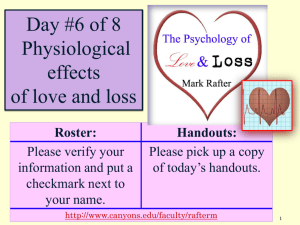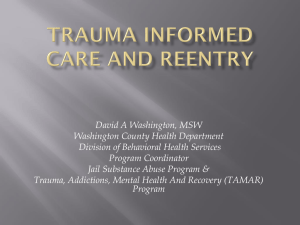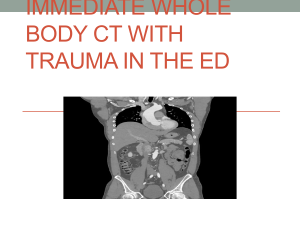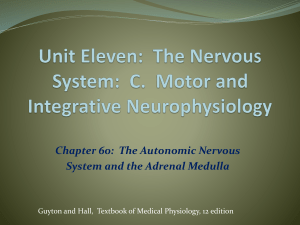steffensen - The Society for the Advancement of Sexual Health
advertisement
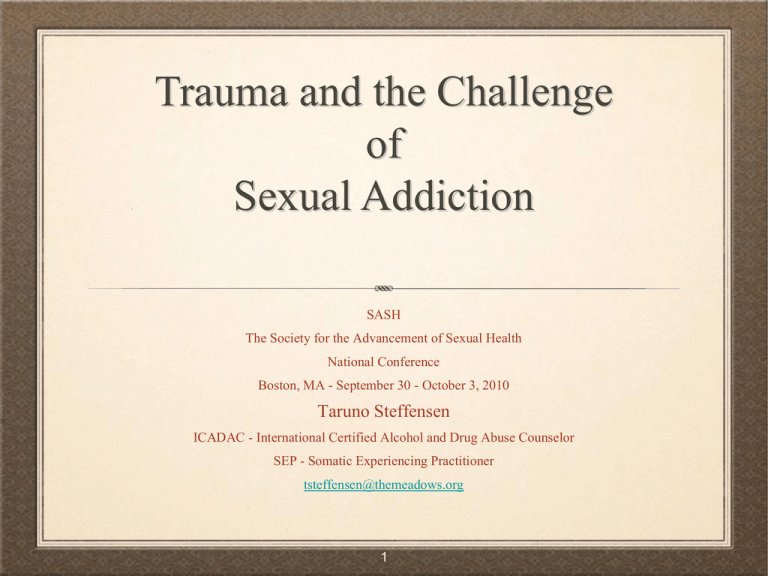
Trauma and the Challenge of Sexual Addiction SASH The Society for the Advancement of Sexual Health National Conference Boston, MA - September 30 - October 3, 2010 Taruno Steffensen ICADAC - International Certified Alcohol and Drug Abuse Counselor SEP - Somatic Experiencing Practitioner tsteffensen@themeadows.org 1 Core Assumption I In the context of trauma, sexual addiction arises not as a pleasure-seeking strategy but as a survival strategy: • To self-soothe and self-regulate • As a way to numb hyperarousal symptoms: intolerable affects, reactivity, impulsivity, obsessive thinking • In the service of walling off intrusive memories • As a way to combat helplessness by increasing hypervigilence and feelings of power and control • To “treat” hypoarousal symptoms of depression, emptiness, numbness, deadening • In the service of facilitating dissociation • As a way to function or to feel safer in the world Fisher, 2007 2 Core Assumption II How the addictive behaviors have helped trauma patients to survive: that is, which trauma symptoms are they attempting to treat through their drinking, drugging, eating disorders, and sexually acting out behaviors. We need to know this information for a number of reasons: • First, we need to know because these are precisely the symptoms that will increase once the patient becomes sober or abstinent • We need to know, too, so that we can begin to anticipate other coping strategies they will need in order to deal with those symptoms as they erupt and threaten to overwhelm them • Furthermore, we need to be able to predict when and how the symptoms may potentially trigger a behavior relapse so that we can help them strengthen the addictions recovery program they have chosen • And finally, we also need to know so that we can help the survivor appreciate their courageous attempts to cope with the effects of the abuse and, from that recognition, develop sufficient compassion and self-respect to counteract the shame and guilt that is the inevitable byproduct of their addictions and trauma history Fisher, 2007 3 What is Trauma? “Trauma is experiencing too much, too fast, too soon.” 4 What is Trauma cont? Trauma is perhaps the most avoided, ignored, belittled, denied, misunderstood, and untreated cause of human suffering. Although it is the source of tremendous distress and dysfunction, it is not an ailment or a disease, but the by-product of an instinctively instigated, altered state of consciousness. We enter this state - let us call it survival mode - when we perceive that our lives are being threatened. If we are overwhelmed by the threat and are unable to successfully defend ourselves, we can become stuck in survival mode. This highly aroused state is designed solely to enable shortterm defensive actions; but left untreated over time, it begins to form the symptoms of trauma. Peter Levine 5 Somatic Experiencing 6 Trauma and the Brain 7 Bessel van der Kolk “The imprint of the trauma is in the limbic system and in the brainstem: in our animal brains, not our thinking brains” 8 The Triune Brain x 9 Pierre Janet 1859-1947 • “[Traumatized] patients ... are [repeatedly] continuing the action, or rather the attempt at action, which began when the thing happened, and they exhaust themselves in these everlasting recommencements.” • 1919/25, p. 663 10 “Bottom-up, The Hi-Jacked Brain” Everyday experiences connected to the trauma will trigger instinctive survival responses: fight, flight, freeze, collapse and numbing, dissociation, re-enactment behavior. The client’s animal brain takes over, the ability to think goes “off line,” & sexually acting out behavior takes place without conscious intention or judgment, even without awareness! Janina Fisher, 2007 11 Trauma vs. Intimacy Visual Cortex Normal Response Trauma Response Amygdala Fight, Flight or Freeze Response 12 Peter Levine “Trauma originates as a response in the nervous system, and does not originates in an event. Trauma is in the nervous system, not in the event.” 13 Brief Overview of the Autonomic Nervous System The Polyvagal Theory by Stephen Porges, PhD www.stephenporges.com 14 The Parasympathetic Nervous System The Sympathetic Nervous System Trauma may result in the PNS staying “on”, which causes it to superimpose shutdown over the hyperarousal of the SNS, rather than discharging its energy. The SNS gets our whole body ready for action. It regulates arousal. It increases activity during times of stress and arousal – whether positive or negative. It is active when we’re alert, excited, or engaged in physical activity. It prepares us to meet emergencies and threat. The Parasympathetic branch acts like the brake pedal for our nervous system. It helps us to relax, unwind and ultimately discharge the arousal of sympathetic activation. The Sympathetic branch is like the gas pedal of our nervous system. It gives us energy for any action we plan, and it helps us prepare for threat. 15 The Polyvagal Theory By Stephen Porges The Vagus Nerve in three parts, all working simultaneously: Ventral Vagal System: Is part of the Parasympathetic Nervous System (Social Engagement/frontal cortex) Sympathetic Nervous System: (Fight/Flight, Freeze - Limbic Brain) Dorsal Vagal System: Is part of the Parasympathetic Nervous System (Freeze/Immobility/Brainstem) 16 17 Social Engagement Safe Ventral Vagal Fight, Flight, Freeze Immobility Sympathetic Nervous System Dorsal Vagal System 18 Danger Life Threatening Edvard Munch “Scream” 19 Autonomic Arousal is Designed to Adapt to Environmental Demands Sympathetic Hyperarousal A R O U S A L easy charge sympathetic easy discharge Window of Tolerance feelings can be tolerated, able to think and feel parasympathetic Parasympathetic Hypoarousal Foundation of Human Enrichment Ogden and Minton (2000) 20 Autonomic Adaptation to a Threatening World Stuck on “ON” Sympathetic Hyperarousal A R O U S A L • Hyperactivity • Panic • Rage • Hypervigilance • Elation/Mania Window of Tolerance Optimal Arousal Zone Stuck on “OFF” Parasympathetic Hypoarousal Foundation of Human Enrichment Fisher, 2006 21 • • • • Depression Disconnection Deadness Exhaustion How Sexual Addiction Modulates and “Medicate” Complex PTSD to attempt Self-Regulation Sympathetic Hyperarousal Sexually Acting out A R O U S A L Window of Tolerance Optimal Arousal Zone Sexually Acting in Parasympathetic Hypoarousal Foundation of Human Enrichment Fisher, 2006 22 The Challenge of Trauma and Sexual Addiction Treatment must address the relationship between the trauma and the addictive behavior: the role of the addictive behavior in “medicating” traumatic activation, the origins of both in the traumatic past, and the reality that recovering from either requires recovering from both Fisher, 2007 23 Bibliography • Van der Kolk, Bessel, (1996) Traumatic Stress. New York: The Guilford Press. • Ogden, Pat, (2006), Trauma and the Body. New York: W.W. Norton & Company, Inc. • Fisher, Janina, (2008), Addictions and Trauma Recovery • Porges, Stephen, 2006), How your nervous system sabotages your ability to relate. www.nexuspub.com • Levine, Peter, (1997), Waking the Tiger. Berkley, CA, North Atlantic Books. 24


